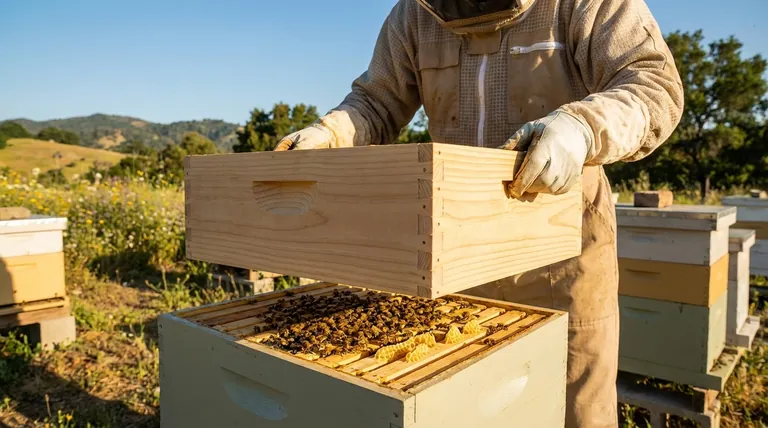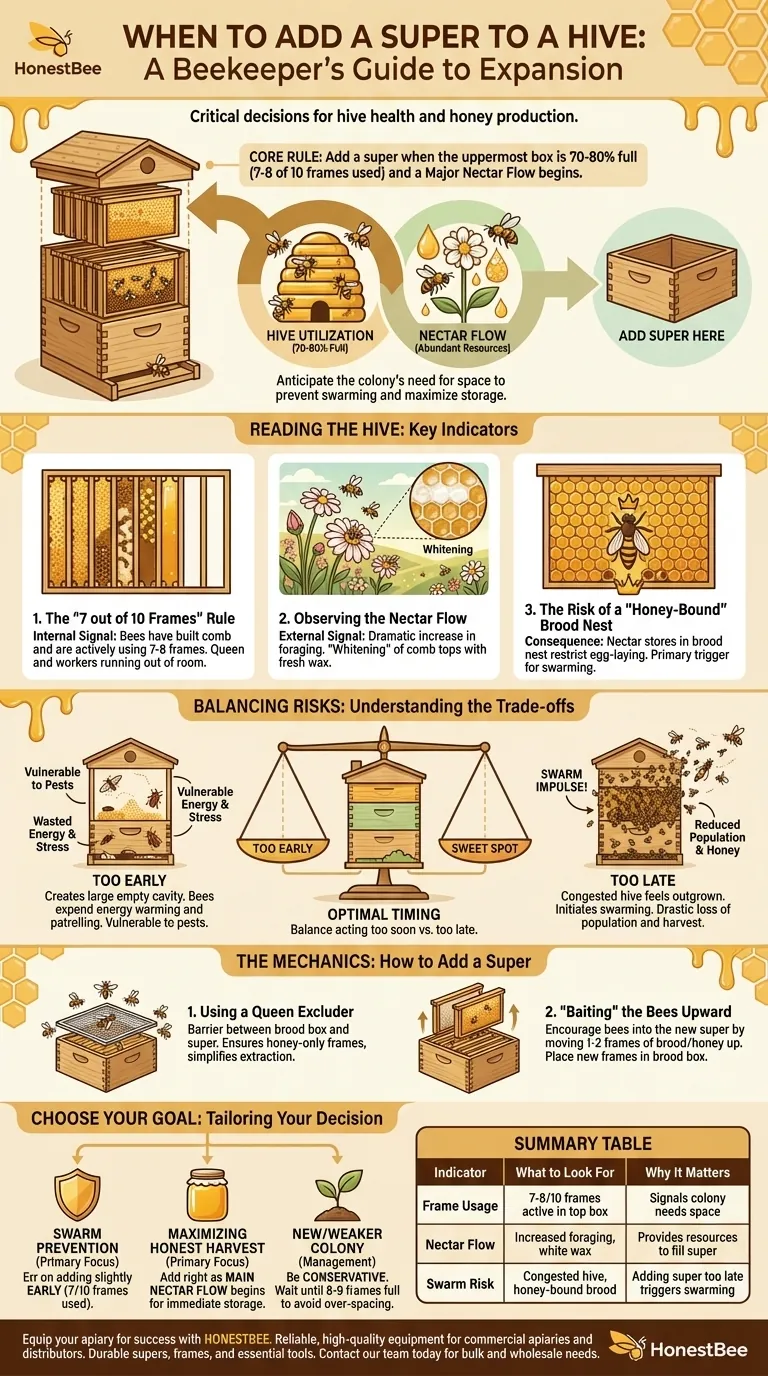Knowing when to add a super is a critical decision that directly impacts hive health and honey production. You should add a new super when the bees have drawn out and are actively using 70-80% of the frames in the uppermost box. This timing should coincide with the start of a major nectar flow, which provides the resources needed to fill the new space.
The core task is not just adding a box; it's about anticipating the colony's need for space. Adding a super at the right moment prevents the hive from swarming and ensures the bees have ample room to store honey during peak nectar collection periods.
Reading the Hive: Key Indicators for Supering
To add a super effectively, you must learn to read the signals the colony and the environment are giving you. These indicators tell you the bees are ready for expansion.
The "7 out of 10 Frames" Rule
The most reliable internal sign is hive population and space utilization. In a standard 10-frame hive, once the bees have built comb and are using seven or eight of the frames for brood, pollen, or honey, they are running out of room.
This is a clear signal that the queen is feeling crowded and the workers have limited space to store incoming nectar.
Observing the Nectar Flow
A nectar flow (or honey flow) is a period when local plants are producing abundant nectar. Adding a super just before or during this time is essential.
Look for external signs like a dramatic increase in foraging activity at the hive entrance. Inside the hive, you may see "whitening," where bees add fresh, white wax to the tops of existing honeycomb to extend the cells for more storage.
The Risk of a "Honey-Bound" Brood Nest
If you wait too long, the bees will begin storing nectar in the empty cells within the brood nest where the queen should be laying eggs. This condition is called being honey-bound.
A honey-bound brood nest severely restricts the queen's ability to lay, which limits colony growth and is a primary trigger for the bees to begin swarm preparations.
Understanding the Trade-offs
The timing of supering involves balancing two competing risks. Your goal is to find the sweet spot between acting too soon and acting too late.
The Danger of Adding a Super Too Early
Adding a super before the colony is strong enough creates a large, empty cavity at the top of the hive. The bees must expend significant energy to patrol and warm this vacant space.
This can stress a smaller colony, slow its development, and make the hive more vulnerable to pests like wax moths and small hive beetles, which thrive in undefended comb.
The Consequence of Adding a Super Too Late
Waiting too long is often the more costly mistake. A congested hive quickly feels it has outgrown its home.
This initiates the swarm impulse, where the bees will raise a new queen and the old queen will leave with up to half the worker bees. This event drastically reduces your hive's population and its potential honey harvest for the season.
The Mechanics of Adding a Super
Once you've decided it's time, the process is straightforward but can be optimized to encourage the bees to accept the new space quickly.
Using a Queen Excluder
A queen excluder is a screen placed between the top brood box and the new honey super. The slots are large enough for worker bees to pass through but too small for the larger queen.
This practice ensures the queen cannot lay eggs in the honey supers, resulting in frames of pure honey that are free of brood. This is a common technique for simplifying the honey extraction process.
"Baiting" the Bees Upward
Bees can sometimes be reluctant to move up through a queen excluder into an empty box. To encourage them, you can "bait" the new super.
Take one or two frames of capped brood or honey from the outer edges of the top brood box and place them in the center of the new super. Place new, undrawn frames into the brood box to replace the ones you moved. The nurse bees will follow the brood up into the super, and the scent of honey will draw other foragers, encouraging them to start working the new space immediately.
Making the Right Choice for Your Goal
Your specific objective should guide your timing. Use these guidelines to tailor your decision-making process.
- If your primary focus is swarm prevention: Err on the side of adding the super slightly early, as soon as you see 7 of 10 frames being actively used.
- If your primary focus is maximizing a honey harvest: Add the super right as the main nectar flow begins to ensure the bees have immediate storage space.
- If you are managing a new or weaker colony: Be more conservative and wait until 8 or even 9 frames are full to avoid giving the bees too much space to manage.
By reading the signals from your bees and the environment, you can provide space exactly when they need it, ensuring a healthy and productive hive.

Summary Table:
| Key Indicator | What to Look For | Why It Matters |
|---|---|---|
| Frame Usage | 7-8 out of 10 frames drawn and active in the top box. | Signals the colony is running out of room and needs space. |
| Nectar Flow | Increased foraging, bees adding white wax to comb. | Provides the resources needed to fill a new super. |
| Swarm Risk | Hive feels congested; risk of a honey-bound brood nest. | Adding a super too late is a primary trigger for swarming. |
Equip your apiary for success with HONESTBEE. Managing hive expansion requires reliable, high-quality equipment. As a trusted wholesale supplier to commercial apiaries and beekeeping equipment distributors, we provide the durable supers, frames, and essential tools you need to support your colonies' growth. Let our expertise and bulk-focused operations help you maximize honey production and maintain hive health. Contact our team today to discuss your commercial or wholesale needs.
Visual Guide

Related Products
- Langstroth Honey Bee Box Hive Boxes for Different Depths
- Australian Langstroth Beehive Boxes for Beekeeping Wholesales
- In-Hive Dual Compartment Frame Bee Feeder for Targeted Colony Nutrition
- HONESTBEE Professional Entrance Bee Feeder Hive Nutrition Solution
- Professional 500g Sectional Comb Honey Frame System for Beekeeping
People Also Ask
- What is the purpose of the boxes in a Langstroth hive? A Guide to Modular Beekeeping Success
- What is the best time to inspect a hive? Optimize for Bee and Beekeeper Safety
- How deep is a medium bee box? Unlock the Key to a Versatile and Manageable Hive
- What are the sizes available for Langstroth boxes? A Guide to 8-Frame vs. 10-Frame & Depths
- How should hive boxes be aligned after reassembly? Ensure a Perfect Seal for Hive Health



















